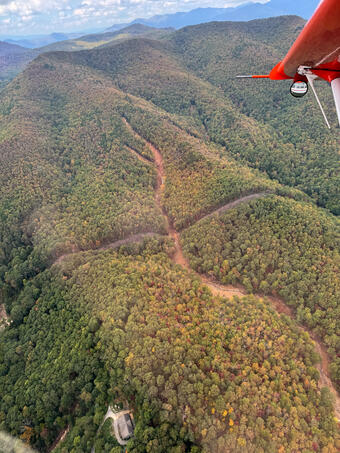USGS landslide event team activated in wake of Hurricane Helene
Scientists begin aerial reconnaissance over landslide zones
ASHEVILLE, N.C. – In response to Hurricane Helene’s devastating effects across multiple states, the U. S. Geological Survey activated its landslide event team and is providing “timely best science” to inform local authorities as they prioritize resources.
“Our thoughts are with the communities and the countless people impacted by this tragic storm,” said Holly Weyers, USGS Southeast Regional Director. “We feel that activating our landslide event team in the aftermath of Helene was an essential step in providing federal, state, emergency managers, and rescue teams with the science information needed to assist with relief efforts. We're actively assisting local authorities both on the ground and from afar as they work to protect lives and vital infrastructure.”
The North Carolina and Tennessee Geological Surveys requested federal assistance after Helene brought record rainfall and river levels across the southern Appalachian Mountains. Landslides can be triggered by rainfall from hurricanes when rainwater fills the gaps in the soil, or the pores, faster than the water can drain resulting in elevated pore water pressure that reduces the strength of the soil and leads to slope failures. These types of landslides can occur suddenly and turn into fast-moving landslides that can travel very far, called debris flows. “We will always activate if a state asks us for help on a landslide issue,” said Eric Bilderback, a supervisory research geologist, who manages landslide hazard and earthquake geology research groups in the USGS’ Geologic Hazards Science Center.
Two USGS landslide experts are currently based in the Knoxville, Tennessee area conducting aerial reconnaissance flights in partnership with U.S.
Fish & Wildlife Service, to get a better understanding of the extent and severity of landslide impacts in the southern Appalachian region. This information is being shared across multiple state and federal agencies including Federal Emergency Management Agency, National Oceanic and Atmospheric Administration, and National Aeronautics and Space Administration. Flights began Thursday and are currently planned through Saturday.
The scientists are flying in a Kodiak Fish & Wildlife fixed-wing aircraft, that can fly at low enough altitude to get below cloud cover for better ground visibility, explained Bilderback.
The data gathered in the flights will also help in confirming the locations of some landslides, which, can be accessed by the public on a newly-launched USGS Landslide Observations Dashboard here: https://www.arcgis.com/apps/dashboards/01b4f51fc0b64002bf7722a9acfc181d. The dashboard is multi-agency collaborative effort to map where landslides have been sighted.
At time of publication, the dashboard shows 230 landslides across North Carolina, Tennessee, and Virginia, depicted in red and grey dots. The red dots are “flagged landslides,” or those that impact rivers, roads, and structures.
Bilderback explained that landslide sightings are coming from a variety of sources such as partner organizations, satellite imagery, and even the public through social media. This dashboard is being continuously updated with more information. The landslide event team does due diligence in attempting to confirm the accuracy of each landslide report, but Bilderback stressed, the Landslide Observations Dashboard is a rapid emergency analysis of the data that’s currently available and provisional data only. Due to the provisional nature of the dashboard, landslide point locations could be inaccurate, and all data is subject to change without notice.
For an overview of the work the USGS is doing on landslides related to Hurricane Helene, please visit: https://www.usgs.gov/programs/landslide-hazards/science/2024-hurricane-helene-landslide-hazards.
Links and contacts within this release are valid at the time of publication.


